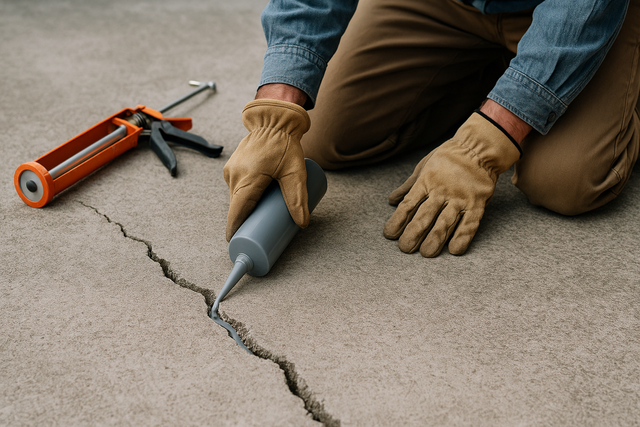Concrete Crack Repair: What Property Owners Should Know Before It’s Too Late
Concrete is one of the most durable materials used in construction, but it’s not invincible. Over time, exposure to moisture, temperature fluctuations, structural movement, and load stress can lead to cracks—some superficial, others more serious. Whether it’s a hairline fracture in a driveway or a structural fault in a high-rise slab, concrete crack repair is a task that demands immediate attention and professional care.
Ignoring cracks in concrete may result in water ingress, corrosion of steel reinforcement, trip hazards, and even structural compromise. The good news? With the right approach and experienced help, most cracks can be treated early and cost-effectively—before they evolve into major repair jobs.
What Causes Cracks in Concrete?
Cracks can develop in concrete for several reasons. Some are cosmetic, while others point to underlying issues that need urgent remediation.
Common causes include:
Shrinkage during curing as water evaporates
Thermal movement, especially in outdoor surfaces
Load stress from vehicles, machinery, or overburdened slabs
Ground movement or subsidence
Corrosion of reinforcement, which expands and breaks the concrete from within
Poor construction practices, including improper mix or curing techniques
Understanding the cause of a crack is the first step in choosing the correct repair method. A misdiagnosis may result in a fix that fails or simply masks a more serious issue.
If you're curious about the science behind concrete deterioration, this Steemit post provides a detailed look at how materials degrade over time.
Types of Concrete Cracks
Not all cracks are created equal. Here’s a quick overview:
Hairline cracks: Very thin and often caused by surface shrinkage.
Plastic shrinkage cracks: Occur while concrete is still wet, often due to rapid evaporation.
Structural cracks: Wide or deep cracks caused by movement, pressure, or subsidence.
Expansion cracks: Caused by temperature changes.
Settlement cracks: Form when the ground beneath the slab shifts or compacts.
Each type of crack requires a tailored repair approach—ranging from simple sealants to high-pressure epoxy injections or structural re-bonding.
Why Timely Repair Is Essential
Cracks in concrete may seem minor at first, but they can lead to serious consequences:
Water ingress: Unsealed cracks allow water to penetrate the slab, leading to erosion, corrosion of steel reinforcement, and internal damage.
Structural failure: Left unaddressed, structural cracks may compromise the integrity of the building or structure.
Trip hazards: For footpaths, stairs, or carparks, even small cracks may pose liability risks.
Pest access: Cracks may allow pests or plant roots to enter and expand the damage.
Decreased property value: Visible cracks may deter buyers or tenants and suggest poor upkeep.
Working with concrete crack repair specialists ensures issues are properly diagnosed and treated using the latest materials and techniques.
Common Methods of Concrete Crack Repair
There is no one-size-fits-all solution. The correct method depends on the type, location, width, and cause of the crack.
Here are some of the most common repair methods:
Epoxy Injection
Used for structural cracks, epoxy is injected under pressure to bond the concrete back together. It restores structural integrity and prevents water ingress.Polyurethane Injection
Ideal for non-structural or water-stopping repairs. The material expands to fill gaps and seal against moisture.Routing and Sealing
The crack is widened and cleaned before being filled with a flexible sealant. Commonly used for flat surfaces like driveways or footpaths.Stitching
Metal staples or U-shaped bars are inserted across the crack to rejoin the slab. This is more invasive and typically used for critical repairs.Overlay or Surface Coating
For cosmetic cracks, a surface treatment or skim coat may hide the damage and protect the surface from further wear.Carbon Fibre Reinforcement
Used in more severe cases, especially in vertical or load-bearing elements, to increase tensile strength.
If you'd like to read more on choosing between sealants and epoxy, this Steemit article provides an insightful comparison.
Choosing the Right Contractor
Concrete repair is a specialised trade. Hiring the wrong contractor may result in ineffective repairs, recurring issues, or non-compliant work. When selecting a repair team, consider:
Experience with both structural and non-structural cracks
Access to diagnostic tools like moisture meters, thermal imaging, or ground-penetrating radar
Knowledge of AS 3600 and AS 2870 compliance requirements
Transparent quoting and reporting
Product warranty and service guarantee
A reliable contractor like trusted crack repair services will walk you through the process, explain what’s needed, and provide a long-term solution—not a temporary patch.
Applications Across Property Types
Concrete crack repair isn’t just for warehouses or carparks. It’s relevant across:
Residential driveways and patios
Basement walls and foundations
High-rise slabs and columns
Retail and industrial floors
Bridges, tunnels, and infrastructure
Swimming pools and retaining walls
Each environment has unique exposure risks—salt air, vehicle traffic, temperature change, or vibration—which must be factored into the repair plan.
Preventing Future Cracks
While not all cracks are avoidable, you can take steps to minimise recurrence:
Use control joints to direct cracking to specific lines
Ensure proper curing when pouring concrete
Seal concrete to protect against moisture penetration
Monitor foundation movement through routine inspections
Avoid overloading slabs beyond their design rating
Maintain adequate drainage to prevent water pooling near slabs
A good contractor won’t just fix the current problem—they’ll help you prevent the next one.
Final Thoughts
Concrete may be tough, but it’s not indestructible. Left unchecked, cracks compromise safety, aesthetics, and structure. The key to long-lasting repair is accurate diagnosis, correct technique, and experienced application.
Whether you're managing an apartment complex, industrial facility, or family home, timely crack repair is a critical part of building maintenance. By engaging concrete crack repair specialists, you can protect your investment and avoid the high costs of structural failure or full slab replacement.
In the world of property care, ignoring cracks is never a wise decision—especially when repair is far easier than rebuild.
